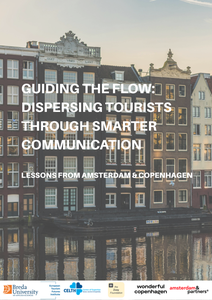City authorities worldwide have sought to rejuvenate and diversify their tourism product offerings by dispersing visitors into less familiar and frequented locales. Despite calls to understand such ‘new tourism areas’ (NTAs) in urban areas, few researchers have examined visitor responses to the implementation of NTA strategies, particularly outside Europe. This quantitative approach considers the profiles, attitudes and behaviours of NTA visitors in an Asian city that was undertaking dispersal efforts pre-pandemic in the context of mass inbound Chinese visitation. Distinct profiles are found for NTA visitors relative to other city arrivals in response to Hong Kong’s branding propositions. It is found that NTAs appeal to repeat visitors seeking cosmopolitan experiences and may help tourist dispersal and product differentiation, though the proposition that NTA visitors are more highly educated was not supported
LINK
DOCUMENT

This article aims to supplement the three “golden rules” of rewilding – or three Cs – the Cores, Carnivores, and Corridors – by a fourth C – Compassion, in discussing the case of Oostvaardeplassen in The Netherlands. The cores refer to large, strictly protected ecologically intact areas, carnivores refer to natural predators, and corridors connect passages for fauna movements. We propose a fourth requirement: Compassion. This fourth C would ensure that any active (re)introduction must be in the interests of the individual animals involved. This article briefly explains the history of the Oostvaardeplassen project and leads into a discussion of the scientific (biological requirements of the species, area, and species fit, etc. ) and ethical (animal welfare, ecocentrism, etc.) constraints and opportunities for rewilding. All four Cs, we argue, are absent from Oostvaardeplassen, which can be considered an example of how rewilding should not be undertaken. Against this background, we propose an alternative way forward. https://www.ecos.org.uk/ecos-406-the-golden-rules-of-rewilding-examining-the-case-of-oostvaardersplassen/ LinkedIn: https://www.linkedin.com/in/helenkopnina/
MULTIFILE

The debate on tourism in cities, both academically and in practice, has for a long time taken place in relative isolation from urban studies. Tourism is mostly addressed as an external agent and economic force that puts pressure on cities rather than as an interdependent part of city systems. The recent debate on city touristification and excessive dependence on the visitor economy, as well as the associated processes of exclusion, and displacement of local city users, serves to highlight how tourism is an integral part of urban developments. A wider urban perspective is needed to understand the processes underlying the tourism phenomena and more transdisciplinary perspectives are required to analyze the urban (tourism) practices. The current article seeks to contribute to such a perspective through a discussion of the literature on urban and tourism studies, and related fields such as gentrification, mobilities, and touristification. Based on this, theoretical reflections are provided regarding a more integral perspective to tourism and urban development in order to engage with a transversal urban tourism research agenda.
MULTIFILE
In the Migrant’s Paradox, Suzanne Hall takes you on an excursion to the world of migrant shop proprietors in the urban margins of five UK cities, exposing it as a world full of controversies and contradictions.
DOCUMENT
DOCUMENT

This chapter takes a closer look at the case of Amsterdam as a particular manifestation of a film festival city. Drawing from a new dataset on festivals in the Netherlands, the data supports the view of film festivals as a highly dynamic cultural sector: Internationally acclaimed film festivals exist beside smaller festivals that are more community bound; new festivals emerge annually, and young festivals struggle to survive the three-to-five-year mark.Amsterdam holds a unique position in the Dutch film festival landscape as a third of all film festivals in the Netherlands take place in the capital city. Our data collection helps to bring parts of the city’s film infrastructure to the forefront. On the one hand, Amsterdam’s top five locations for film festival events show clear creative cities logic: The data shows just how powerful the pull of such locations is. On the other hand, we find evidence of placemaking and livable city strategies: Amsterdam’s film festivals extend into the capillaries of the city.Dedicated festival datasets may cast new perspectives on local or national festival landscapes, by revealing patterns that remain hidden in qualitative and case-study based projects. But there are also challenges to address in data-driven research on festival cultures, we name a few such as categorization of data. We conclude that such challenges can be more easily faced if more datasets, of for instance, other cities, are pursued and become available.
MULTIFILE
Deliverable 7.3 of the Horizon 2020 project SmartCulTour (GA number 870708), published on theproject web site on (30-11-2022): http://www.smartcultour.eu/deliverables/
MULTIFILE
